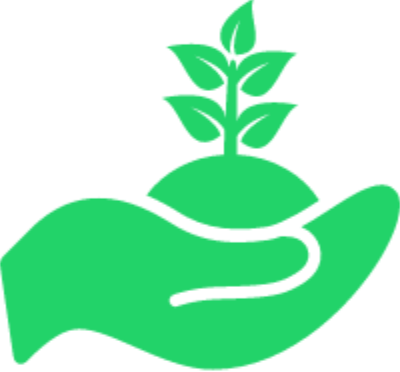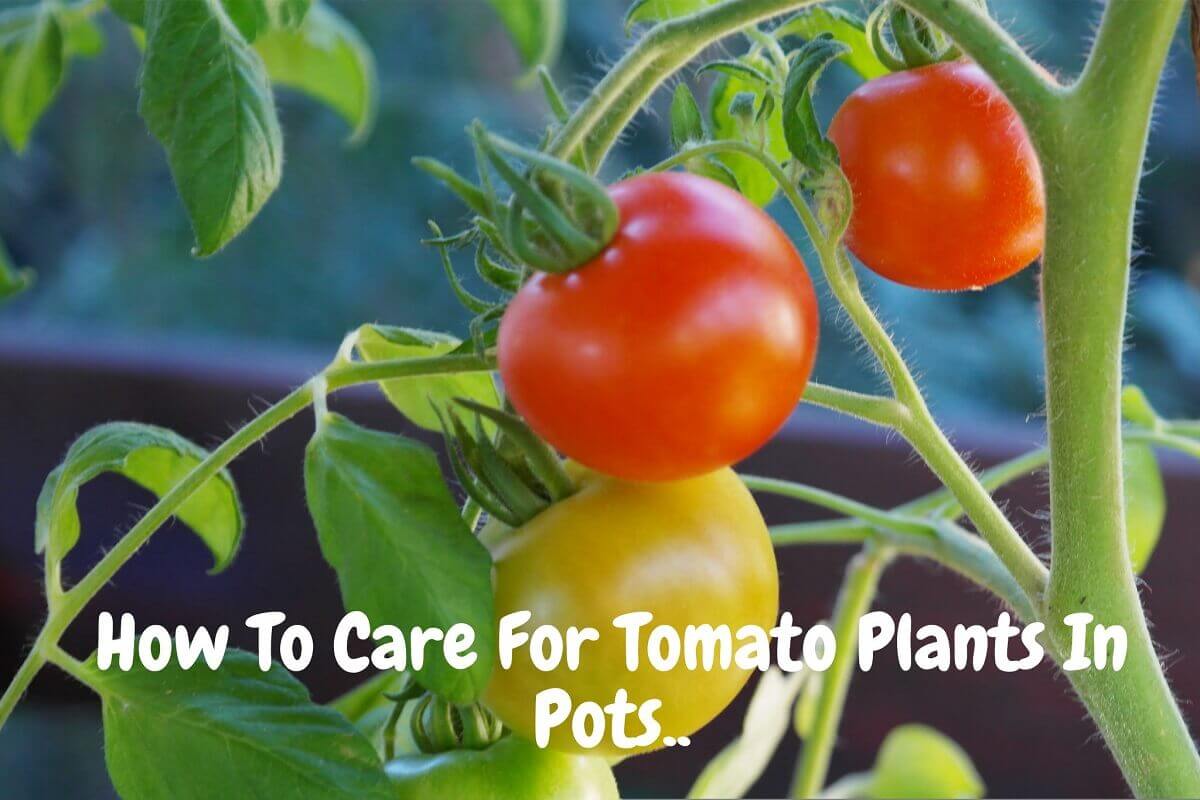To care for tomato plants specially when you grow it in pots, it is important to choose a pot or container with appropriate size, use well-draining potting soil, provide regular watering making sure that the soil is moist but not waterlogged, support the plant, remove any suckers, monitor for pests and diseases and provide adequate sunlight and ventilation. By following these above steps, you can ensure that your tomato plants thrive and produce a bountiful harvest. Lets dive into deep the steps.
1. Choose A Big Pot
Selecting the appropriate pot size is essential for the successful growth of tomato plants in pots. A pot that is too small may restrict root growth and prevent the plant from reaching its full potential. A pot that is too large on the other hand may hold too much water causes the soil to become waterlogged, which can lead to root rot.
The recommended size of pot for growing tomato plants in pots is at least 18 inches in diameter and 12 inches deep. This size provides enough space for the roots to grow and enough soil to hold moisture and nutrients. Additionally, a larger pot will provide more stability for the plant as it grows and allow for adequate support structures like stakes or trellises. Smaller varieties, such as cherry tomatoes, may require a smaller pot, while larger varieties, such as beefsteak tomatoes, may need a larger pot.
2. Prepare Soil
A well-prepared soil will create a favorable environment for the tomato plants, promote root growth, and ultimately lead to a healthy and productive plant.
To prepare the soil for tomato plants in pots, it’s recommended to use a high-quality potting soil that is specifically designed for container gardening. This soil should be loose and well-drained, with a balanced mixture of organic matter, perlite or vermiculite, and other essential nutrients.
Adding compost or organic fertilizer to the soil can also help to provide additional nutrients that the tomato plant needs to grow and produce fruit. Compost can improve soil structure, increase water retention, and promote beneficial microbial activity, while fertilizer can provide specific nutrients, such as nitrogen, phosphorus, and potassium.
| READ MORE: How to Prepare Soil for Vegetable Gardening. |
3. Be Careful About Overwater
Overwatering can have a significant impact on the growth and health of tomato plants in pots. When plants are overwatered, the soil becomes waterlogged, which can lead to several issues including the root rot.
Firstly, overwatering can cause the roots of the tomato plant to suffocate and rot. This can result in stunted growth, yellowing leaves, and even plant death. Secondly, overwatering can leach essential nutrients from the soil, making them unavailable to the plant. This can lead to nutrient deficiencies, which can manifest as yellowing or discolored leaves, poor fruit development, and reduced yields.
Additionally, overwatering can create ideal conditions for fungal diseases to thrive, such as root rot and damping off. These diseases can quickly spread throughout the plant, causing significant damage or even death.
To avoid overwatering, it’s important to ensure that the soil is well-draining and not waterlogged. Water the tomato plants deeply, but less frequently, allowing the top inch of soil to dry out before watering again. It’s also important to use pots with drainage holes to allow excess water to escape and to avoid leaving water in saucers or trays under the pot.
4. Fertilize Your Tomato Plants Regularly
Fertilizers play a critical role in the growth and development of tomato plants in pots by providing essential nutrients that are necessary for healthy growth and fruit development.
While potting soil typically contains some nutrients, these nutrients can become depleted over time as the plant grows and absorbs them. In that case, organic fertilizers can play a vital role because they are derived from natural sources such as plant matter, animal waste, and other organic materials, which can be beneficial for potted tomato plants. These fertilizers provide a steady supply of nutrients to the plant over time, which can help prevent nutrient burn and other issues associated with over-fertilization.
It’s important to use the right type and amount of fertilizer. Too much fertilizer can lead to nutrient burn and damage the plant, while too little fertilizer can result in poor growth and yields. It’s recommended to use a slow-release fertilizer designed for container gardening, and to follow the manufacturer’s instructions for application rates and frequency.
Regular fertilization, along with proper watering and soil preparation, can help ensure healthy growth and optimal fruit production for tomato plants in pots.
5. Feed The Plants with Sun Exposer
To develop healthy tomato plants and produce fruit, it require at least 6-8 hours of direct sunlight every day. Without adequate sunlight, the plants may grow weak, produce fewer flowers and have a lower yield of fruit.
It’s, however, also important to note that too much sun exposure can be harmful to tomato plants, especially during the hottest parts of the day. Overexposure to the sun can cause the plants to wilt, dry out, and even burn.
To ensure that your tomato plants get the right amount of sun exposure, it’s best to place the pots in a location that receives morning or evening sun as well as some shade during the hottest part of the day. It’s better to use shade cloths to provide some protection during the hottest parts of the day.
6. Provide Support
Support is crucial for potted tomato plants to ensure their proper growth and health. These plants can become top-heavy and prone to falling over due to their limited root systems in containers. Providing support helps keep the plants upright and prevents damage to stems and fruit. This support also allows for better air circulation, which is essential in preventing fungal diseases that can thrive in humid conditions.
Additionally, supporting potted tomato plants can increase their exposure to sunlight, promoting better growth and fruit production. It also facilitates easier harvesting, as the fruit is more accessible without damaging the plant. Overall, supporting potted tomato plants is essential to promote their productivity and prevent damage, making it an important aspect of their care.
7. Pay Attention to Prevent Pests
Controlling pests and preventing infestations in potted tomato plants is an essential aspect of their care. Pests can cause significant damage to the plants, leading to reduced yields and, in severe cases, plant death.
To prevent pest it is important to start with healthy plants that are free from any signs of damage or infestation. Additionally, gardeners should use clean soil and containers to prevent any potential pests or disease from carrying over from previous plantings.
For the prevention or treatment of pests in tomato plants, the following things should be keep in mind:
- Good hygiene practices
- Remove any debris or dead leaves
- Use physical barriers, such as row covers or netting
- Plant companion plants such as marigolds that attract beneficial insects. Beneficial insects, such as ladybugs or lacewings can help control pest populations naturally.
- Use natural insecticides, such as insecticidal soap or neem oil
Bottom Line
In conclusion, growing tomato plants in pots can be a rewarding and enjoyable experience, but it requires proper care and attention. Tomato plants need sufficient sunlight, water, and nutrients to thrive, and gardeners specially beginners must provide appropriate support and maintenance to ensure healthy growth.
Adequate soil preparation, regular fertilization, and pruning are necessary for optimal growth and fruit production. Pests and diseases are common threats that can cause significant damage to potted tomato plants, and one must take steps to prevent and control infestations. By following the tips outlined in this guide, gardeners can ensure healthy and productive tomato plants in their pots. With proper care, attention, and patience, gardeners can enjoy a bountiful harvest of delicious and nutritious tomatoes from their potted plants.
FAQs on How to Care For Tomato Plants in POTs
What is the best fertilizer for tomatoes in pots?
Organic fertilizers such as compost, manure, and fish emulsion can be used for potted tomatoes, as they provide a natural source of nutrients that can improve soil quality and support healthy plant growth. These types of fertilizers are also less likely to burn plants if overused.
On the other hand, a balanced fertilizer that contains equal parts of nitrogen, phosphorus, and potassium (NPK) is a good choice for tomatoes in pots. A slow-release fertilizer can also be beneficial, as it will release nutrients over a longer period of time and reduce the risk of over-fertilization.
Should I water tomatoes in pots every day?
Watering tomato plants in pots will depend on several factors, including the size of the pot, the weather conditions, and the stage of growth of the plant. As a general rule, potted tomatoes should be watered deeply and regularly, but not necessarily every day.
Tomatoes require consistent moisture to grow and produce fruit, so it’s important to keep the soil evenly moist, but not waterlogged. Overwatering can lead to root rot and other issues, while under-watering can cause stress and reduced fruit production.
When should I stop feeding my tomatoes?
As a general rule of thumb, you should stop feeding tomato plants with nitrogen-rich fertilizers 4-6 weeks before the first expected frost in your area. This allows the plant to focus its energy on ripening the fruit instead of producing new growth. However, you should continue to provide a balanced fertilizer that contains phosphorus and potassium to support the plant’s ongoing nutrient needs.
It’s important to note that over-fertilization can lead to problems such as blossom end rot, which can damage the fruit. Be sure to follow the manufacturer’s instructions when applying fertilizer, and avoid applying too much or too frequently. Observing the plant’s growth and health can also help you determine when to stop feeding it.

